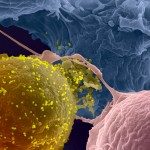Link to Pubmed [PMID] – 31915276
J. Virol. 2020 Jan;
HIV-2 Long Terminal Repeat (LTR) region contains several transcription factors (TF) binding sites. Efficient LTR transactivation by cellular TF and viral proteins is crucial for HIV-2 reactivation and viral production. Proviral LTR sequences of 66 antiretroviral-naïve HIV-2-infected patients included in the French ANRS HIV-2 CO5 cohort were sequenced. A high genetic variability within HIV-2 LTR was observed, notably in the U3 sub-region, the sub-region encompassing most known TF binding sites. Genetic variability was significantly higher in HIV-2 group B than in group A viruses. Notably, all group B viruses lacked the peri-ETS binding site and 4 group B sequences (11 %) also presented a complete deletion of the first Sp1 binding site. The lack of a peri-ETS binding site was responsible for a lowered transcriptional activity in activated T lymphocytes, while deletion of the first Sp1 binding site lowered basal or Tat-mediated transcriptional activities, depending on the cell line. Interestingly, HIV-2 cellular reservoir was less frequently quantifiable in patients infected by group B viruses and, when quantifiable, reservoirs were significantly smaller than in patients infected by group A viruses. Our findings suggest that mutations observed in HIV-2 LTR sequences are associated with differences in transcriptional activity and may explain the low cellular reservoir in patients infected by HIV-2 group B viruses, providing a new insight into the reduced pathogenicity of HIV-2 infection. Over 1 million patients are infected with HIV-2, which is often described as an attenuated retroviral infection. Patients have frequently undetectable viremia and evolve at a slower rate towards AIDS than HIV-1-infected patients. Several studies have reported a smaller viral reservoir in Peripheral Blood Mononuclear Cells in HIV-2-infected patients, compared to HIV-1-infected patients, while others have found similar sizes of reservoirs but a reduced number of cell-associated RNA, suggesting a block in HIV-2 transcription. Recent studies have found associations between mutations within HIV-1 LTR and reduced transcriptional activities. Until now, mutations within the HIV-2 LTR region have scarcely been studied. We conduct this research to identify if such mutations exist in HIV-2 LTR, and their potential association with viral reservoir and transcriptional activity. Our study indicates that transcription of HIV-2 group B proviruses may be impaired, which might explain the low viral reservoir observed in patients.


